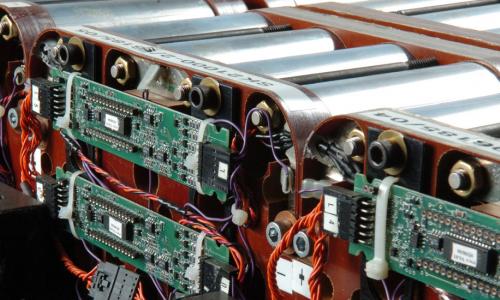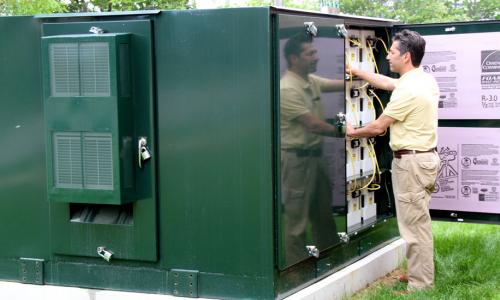Table of Contents
One of the keys to achieving high levels of renewable energy on the grid is the ability to store electricity and use it at a later time.
Much like refrigerators enabled food to be stored for days or weeks so it didn’t have to be consumed immediately or thrown away, energy storage lets individuals and communities access electricity when they need it most—like during outages, or when the sun isn’t shining. Storage can reduce demand for electricity from inefficient, polluting plants that are often located in low-income and marginalized communities. Storage can also help smooth out demand, avoiding price spikes for electricity customers.
The electricity grid is a complex system in which power supply and demand must be equal at any given moment. Historically, supply has been adjusted to meet changes in demand, from the daily patterns of human activity to unexpected changes such as equipment overloads, wildfires, storms, and other extreme weather events. Now, we also look to flexibility in electricity demand to help optimize use of renewables, from how we heat and cool our homes to when we charge electric vehicles. Energy storage plays an important role in this balancing act and helps to create a more flexible and reliable grid system.
For example, when there is more supply than demand, such as during the night when continuously operating power plants provide firm electricity or in the middle of the day when the sun is shining brightest, the excess electricity generation can be used to charge storage devices. When demand is greater than supply, storage facilities—even those in individuals’ homes—can discharge their stored energy to the grid.
Pumping water back behind hydroelectric dams has been used for decades as a form of storage that absorbs excess generation from the grid and generates electricity later when it is needed by releasing the water to drive a turbine. Now, lithium-ion battery storage in the form of large battery banks is becoming more commonplace in homes, communities, and at the utility-scale.
What is energy storage and how does it work?
Simply put, energy storage is the ability to capture energy at one time for use at a later time. Storage devices can save energy in many forms (e.g., chemical, kinetic, or thermal) and convert them back to useful forms of energy like electricity.
Although almost all current energy storage capacity is in the form of pumped hydro and the deployment of battery systems is accelerating rapidly, a number of storage technologies are currently in use.
Pumped Hydroelectric Storage
Pumped hydroelectric storage turns the kinetic energy of falling water into electricity, and these facilities are located along the grid’s transmission lines, where they can store excess electricity and respond quickly to the grid’s needs (within 10 minutes). The systems consist of two reservoirs at different elevations, and they store energy by pumping water into the upper reservoir when supply exceeds demand. When demand exceeds supply, the water is released into the lower reservoir by running downhill through turbines to generate electricity.
Although a few new projects are in the planning stages, most of pumped hydro systems were built in the 1970s to accompany the new fleet of nuclear power plants. Because nuclear power plants are not designed to ramp up or down, their generation is constant at all times of the day. When demand for electricity is low at night, pumped hydro facilities store excess electricity for later use during peak demand. These pumped hydro plants have proven valuable for quickly adjusting to small changes in demand or supply.
Batteries
Batteries store electricity through electro-chemical processes—converting electricity into chemical energy and back to electricity when needed. Types include sodium-sulfur, metal air, lithium ion, and lead-acid batteries. Lithium-ion batteries (like those in cell phones and laptops) are among the fastest-growing energy storage technologies because of their high energy density, high power, and high efficiency. Currently, utility-scale applications of lithium-ion batteries can only provide power for short durations, about 4 hours. Residential storage can last longer depending on the model, size, capacity, and demands of the home.
Batteries can be sited at the generator, along transmission lines, or in the distribution system. They also have a variety of end uses, such as in commercial buildings, residences, and electric vehicles. Advances in lithium-ion battery technologies have been made largely due to the expanding electric vehicle (EV) industry.
A number of critical materials are rare but essential for lithium-ion batteries. With these materials come international environmental justice concerns, such as with cobalt. This points to the need for fair labor standards and strong environmental standards to govern all critical material extraction processes, as well as transparency in battery manufacturing supply chains. Equally essential is continued research and development to identify substitute materials or technologies (for example, zinc-air batteries) that could move battery production away from dependency on mining for critical materials, especially in places without environmental and labor standards or where human rights violations occur.
Thermal Storage
Concentrated solar power (CSP) is a system that collects solar energy using mirrors or lenses and uses the concentrated sunlight to heat a fluid to run a turbine and generate electricity. The heat can either be used immediately to generate electricity or be stored for later use, which is called thermal storage. The hot fluid can be water, molten salts, or other molten materials and is stored at high temperature in large tanks until needed. There are different designs for collecting and concentrating solar energy. In the United States, most CSP facilities are located in the desert southwest, including one of the largest in the world, the 399-MW Ivanpah Solar Power Facility.
Thermal storage also refers to systems that offset the need for electricity, rather than being used directly to generate electricity. One way is to use air conditioning to freeze water at night using off-peak electricity. During the day when demand for cooling is high, the ice is melted and cool air is passed over the air conditioning condenser coils to reduce the electricity needed to keep the building cool. Such systems are in use in a number of commercial buildings, including at the University of Arizona and for state government buildings at the North Carolina capitol campus.
Compressed Air
Compressed Air Energy Storage (CAES) is a system that uses excess electricity to compress air and then store it, usually in an underground cavern. To produce electricity, the compressed air is released and used to drive a turbine. In a typical CAES design, the compressed air is used to run the compressor of a gas turbine, which saves about 2/3 of the energy needed to operate the turbine. This leads to a reduction in natural gas consumption and can cut carbon dioxide emissions by 40 to 60 percent depending on the design. CAES systems have a large power rating, high storage capacity, and long lifetime. However, because CAES plants require an underground reservoir, there are limited suitable locations for them.
Only two commercial CAES plants exist in the world today, located in Germany and Alabama.
Flywheels
Flywheel Energy Storage Systems convert electricity into rotational kinetic energy stored in a spinning mass. The flywheel is enclosed in a cylinder and contains a large rotor inside a vacuum to reduce drag. Electricity drives a motor that accelerates the rotor to very high speeds (up to 60,000 rpm). To discharge the stored energy, the motor acts as a generator, converting the stored kinetic energy back into electricity.
Flywheels typically have long lifetimes and require little maintenance. The devices also have high efficiencies and rapid response times. Because they can be placed almost anywhere, flywheels can be located close to the consumers and can store electricity for distribution.
While a single flywheel device has a typical capacity on the order of kilowatts, many flywheels can be connected in a “flywheel farm” to create a storage facility on the order of megawatts. Beacon Power currently operates the two largest flywheel short-term energy storage plants in the United States, one in New York and one in Pennsylvania. Each plant an operating capacity of 20 MW and is primarily used for frequency regulation to balance changes in power supply and demand.
Hydrogen
Hydrogen can serve as a form of clean energy storage when renewable electricity is used to split water into hydrogen and oxygen through a process called electrolysis. Hydrogen can be stored in large volumes in underground caverns, or in smaller volumes in storage tanks. Stored hydrogen can later be used in a variety of end uses, from chemical feedstocks to maritime shipping. It can be turned back into electricity via fuel cells or in combustion turbines; while fuel cells only generate water as a byproduct, the combustion of hydrogen can produce health-harming NOx emissions.
Current US energy storage capacity
As of 2020, the United States had over 24 gigawatts (GW) of storage capacity, approximately equal to the capacity of *40 typical coal plants, of which 22.9 GW were pumped hydroelectric storage. This almost complete reliance on hydroelectric storage is changing—in 2019, the number of large-scale battery storage systems grew 28 percent compared with 2018. Capital costs for battery storage fell 72 percent between 2015 and 2019. That trend is set to continue and will likely accelerate lithium-ion battery deployment. The Energy Information Administration (EIA) projects an additional 10 GW of battery storage to be installed in the three years between 2021 and 2023, compared with less than 2 GW operating in 2020.
As battery storage costs continue to fall, as more storage technology options emerge, and as the US continues its transition to a cleaner energy economy, energy storage will play an even greater role.
What are the benefits of energy storage?
Benefits for a Flexible Clean Energy Grid
One reason that the deployment of energy storage is accelerating is that it increases flexibility in grid operations, offers multiple services, and can be used in different applications. Storage systems can also be located in multiple segments of the electricity grid—in the transmission network, the distribution network (where electricity is delivered to consumers), the generator (for example, co-located with wind or solar), and in the case of smaller scale systems, at the commercial building or residential level.
Because some renewable energy technologies–such as wind and solar–have variable outputs, storage technologies have great potential for smoothing out the electricity supply from these sources and ensuring that the supply of generation matches the demand. If charged during periods of excess renewable generation and discharged at times of increased demand, energy storage can help maximize the use of renewable energy and ensure that less is wasted. And residential battery storage can help the utility to balance electricity customer demand with power supply to better align the more variable wind and solar supply with electricity demand.
More broadly, storage can provide electricity in response to changes or drops in electricity, provide electricity frequency and voltage regulation, and defer or avoid the need for costly investments in transmission and distribution to reduce congestion. Energy storage is also valued for its rapid response–battery storage can begin discharging power to the grid very quickly, within a fraction of a second, while conventional thermal power plants take hours to restart. This rapid response is important for ensuring the stability of the grid when unexpected increases in demand occur.
Energy storage also becomes more important the farther you are from the electrical grid. Homes in rural communities that are farther away from the transmission grid are more vulnerable to disruption than homes in large metropolitan areas. Islands and microgrids have smaller service areas that are (or can be) disconnected from the larger electrical grid. Because they may not be able to rely on the larger grid, these communities can use energy storage to avoid blackouts.
Benefits to Communities
Deployment of energy storage can increase access to and deliver benefits for low-income communities and communities historically overburdened with the impacts of pollution and climate change.
A key benefit of energy storage is its ability to provide the grid services currently fulfilled by fossil fuel peaker plants—or “peakers”— that only operate during limited times throughout the year at periods of extremely high demand for electricity, such as during a heat wave. Peaker plants are usually sited in areas of high electricity demand like urban centers—often in or near low-income communities or communities of color. Most peakers are powered by natural gas (although a few even run on coal, oil, and diesel fuel), increasing air pollution and exacerbating already poor public health impacts in these overburdened communities. Energy storage can replace existing dirty peaker plants, and it can eliminate the need to develop others in the future. Battery storage is already cheaper than gas turbines that provide this service, meaning the replacement of existing peakers will accelerate in the coming years.
Related to this, storage can help customers avoid peak pricing (price spikes) by smoothing out demand. Similar to how car rideshare services spike in prices on holidays or other times of high demand, in some places electricity gets more expensive when demand is high, such as during heat waves as more people rely on air conditioning. Energy storage can reduce high demand, and those cost savings could be passed on to customers.
Community resiliency is essential in both rural and urban settings. Energy storage can help meet peak energy demands in densely populated cities, reducing strain on the grid and minimizing spikes in electricity costs. Energy storage can help prevent outages during extreme heat or cold, helping keep people safe. Storage can be used alone or in addition to community solar or aggregated home or commercial building rooftop solar projects to create community-level microgrids or resiliency hubs. By providing localized backup power, these systems can help communities during natural disasters—for example, in meeting energy demands during floods, wildfires, and extreme weather events, all of which are becoming more frequent and intense with climate change.
By charging storage facilities with energy generated from renewable sources, we can reduce our greenhouse gas emissions, decrease our dependence on dirty fossil fuel plants contributing to pollution and negative health outcomes in communities, and even increase community resilience with solar plus storage systems.
The future of energy storage
While some technologies like pumped hydro and lead acid batteries are mature, and others like lithium-ion batteries are scaling rapidly, cutting edge research and development is underway to drive the deployment of new storage technologies.
The US Department of Energy (DOE)’s Advanced Research Projects Agency–Energy (ARPA-E) has a program dedicated to research on storage that can provide power for long durations (10-100 hours). Extended discharge of storage systems can enable long-lasting backup power and even greater integration of renewable energy. Even longer duration storage technologies (seasonal energy storage) can help offset peak electricity needs during parts of the year by saving excess renewable energy from other times of the year, but they face economic and efficiency challenges that will need to be overcome.
While lithium-ion batteries are scaling quickly and falling in cost, they cannot yet address these kinds of problems because they discharge economically over short durations (usually only up to 4 hours at full power capacity). ARPA-E funds a variety of research projects in energy storage in addition to long-duration storage, designed to support promising technologies and improvements that can help scale storage deployment.
With the support of government and industry, research and development for energy storage technologies can continue to develop and expand. The demand for storage will persist because of its unique role in energy resiliency and its ability to help store an ever-growing amount of clean and variable renewable energy to the benefit of all communities in the future.
Widespread deployment of energy storage technology over the next few decades can go a long way toward meeting the science-driven target of reaching net zero emissions by mid-century.
*Assumes typical coal plant capacity of 600 MW.
For more information on community-level and large-scale battery storage see our frequently asked questions page and our Energy Storage Hub page.







